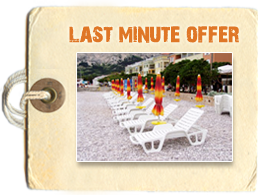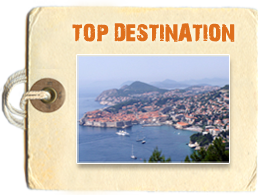
Zagreb, the capital of Croatia is situated on the slopes of Medvednica Mountain (Zagrebacka Gora) and along the banks of the Sava river. Zagreb has a population of 706,770 inhabitants and is located 170 km from the Adriatic Sea, 122 m above sea level. The average summer temperature is about 20° C and the average winter temperature about 1° C.
The favourable geographic position in the south-western part of the Pannonian Basin which extends to the Alpine, Dinaric, Adriatic and Pannonic regions, provides the best valuation of traffic connection between Central Europe and the Adriatic Sea.
The city core comprises the mediaeval parts of the town called Gradec (Gric) and Kaptol. The construction of the railway embankment (1860) enabled the old suburbs, which did not represent an urban whole up to then, to merge gradually into Donji Grad, characterized by a regular block pattern. Between the two World Wars working-class quarters emerged between the railway and the Sava, and residential quarters on the hills of the southern slopes of Medvednica. The blocks between the railway and the Sava were built after the Second World War, and from the mid-1950s new residential areas south of the Sava river, the so-called Novi Zagreb (New Zagreb).
The cargo railway hub and the international airport Pleso were built south of the Sava.
The biggest industrial zone (Zitnjak) in the south-east represents an extension of the industrial zones on the western and eastern outskirts of the city, between the Sava and the Prigorje region. Urbanized lines of settlements connect Zagreb with the centres in its surroundings: Sesvete, Zapresic, Samobor, Dugo Selo and Velika Gorica.
The traffic position, concentration of industry (metal-processing, electrical appliances, textiles, chemicals, pharmaceuticals, printing and leather industries, wood processing, paper etc.), scientific and research institutions and industrial tradition underlie its leading economic position.
Zagreb seats central state administrative bodies (legislative, judiciary, executive, monetary, defence, health care, cultural, educational, traffic, etc.). There are three main traffic communications: the western, towards Ljubljana, i.e. West Europe; the eastern, towards South-eastern Europe and the Near East; the south-western, towards Rijeka, Croatia's biggest port.
The railway running along the Sutla river and the Zagorje main road (Zagreb - Maribor - Vienna), as well as traffic connections with the Pannonian region and Hungary (the Zagorje railroad, the roads and railway to Varazdin and Koprivnica) are linked with the trunk routes. The railway connection with Bosnia and Herzegovina, along the Una valley to Split, is currently out of use due to the war damage.
Tourism
Zagreb is a substantial tourist centre, not only in terms of transit from West and Central Europe to the Adriatic Sea but also as a tourist destination.
Since the end of the war it has attracted a fair number of tourists, but many tourists that visit Croatia skip Zagreb in favour of the beaches along the Adriatic coast and the even older historic cities such as Dubrovnik, Sibenik, Zadar and others.
Nevertheless, Zagreb celebrated its 900th birthday in 1994 and it is not only rich in cultural and historical monuments, museums and galleries, but it also has a variety of modern shops, and offers good quality of diversified restaurants as well as sports and recreation facilities. It is a big centre of congress tourism, economic and business events and trade fairs not only in Croatia but also in this part of Europe. Being an important junction point, it has road, air, railway and bus connections with European metropolises and all bigger cities and tourist resorts in Croatia.
The historical part of the town, the Upper Town and Kaptol, are a unique urban core even in European terms, and thus represent the target of sightseeing tours. The old town's streets and squares can be reached on foot, starting from Ban Josip Jela 269 263; Square, the central part and the heart of Zagreb, or by a funicular on nearby Tomićeva Street. The old core of the town includes many famous buildings, churches, museums and institutions as well as pleasant restaurants and coffee bars.
The history, art and culture not only of Zagreb and Croatia but also of Europe and the world, can be seen by walking through the large number of Zagreb museums. Around thirty collections in museums and galleries comprise more than 3.6 million various exhibits, excluding church and private collections. Only the Archaeological Museum (Nikola Subic Zrinski Square 19) disposes of 400,000 objects, not all of them being exhibited. The holdings include evidence of Croatian presence in this area as well as rare samples which made the museum known in the whole world. The most famous are the Egyptian collection, the mummy and bandages with the oldest Etruscan inscription in the world as well as the numismatic collection. A part of the museum is set aside for the collection of stone monuments dating back predominantly to the Roman -period.
The Croatian Museum of Natural Sciences (Demetrova Street 1) holds the world's most extensive collection of the remains of Neanderthal man found on one site - the remains of the pre-historic man of Krapina and stone weapon and tools. The Technical Museum (Savska Street 18) keeps the oldest preserved machine in this area, dating from 1830 which still operates. Valuable historical collections are found in the Croatian Historical Museum, the Museum of the City of Zagreb, the Museum of Arts and Crafts, the Ethnographic Museum, the Croatian School Museum, the Croatian Hunting Museum, the Croatian Sports Museum, the Croatian Post and Telecommunications Museum, the HAZU (Croatian Academy of Arts and Sciences) Glyptotheque (collection of monuments), the HAZU Graphics Cabinet.
Many visitors find the Mimara Museum (Roosevelt Square 5), housing the donation by Wiltrud and Ante Topic Mimara, very attractive. Of the total of 3,700 most various works of art, more than 1,500 exhibits constitute permanent holdings, dating from the pre-historic period up to the 20th century. The HAZU Strossmayer Gallery of Old Masters (Zrinski Square 11) offers permanent holdings presenting European paintings from the 14th to the 19th centuries, and the Mestrovic Studio, (Mletacka Street 8) with sculptures, drawings, lithography portfolios and other items, is a donation of this great artist to his homeland.
The Museum of Contemporary Art (Catherine's Square 2) follows and presents contemporary trends in fine arts. The Museum and Gallery Centre (Jezuitski Square 4) introduces on various occasions the Croatian and foreign cultural and artistic heritage. The Art Pavilion (King Tomislav Square 22) is the oldest exhibition complex in the Slavic south with regularly organized exhibitions. The exhibitions are also held in the impressive Mestrovic's building on Hrvatskih Velikana Square - the Home of the Croatian Fine Artists. The Museum of Naive Art (Cirilometodska Street 3) disposes of more than one thousand works by a hundred and odd authors of the Croatian naive art. The World Centre "Wonder of Croatian Naive Art" (Ban Jelacic Square 12) exhibits masterpieces of the Croatian naive art as well as works of new generation of artists. The Modern Gallery (Hebrangova Street 1) comprises all relevant fine artists of the 19th and 20th centuries.
The city offers rich cultural and artistic enjoyment. There are about 20 permanent or seasonal theatres and stages. The Croatian National Theatre is the most impressive building among them; the most famous of concert halls is the Concert Hall "Vatroslav Lisinski", named after the composer of the first Croatian opera.
Zagreb hosts many domestic and international events. The World Festival of Animated Films takes place each even year, and the Music Bien-nial, the international festival of avant-garde music, every odd year. The Festival of the Zagreb Philharmonic and the famous flowers exhibition Floraart (end of May or beginning of June), the Old-timer Rally, the Week of the Contemporary Dance, as well as Eurokaz, the international festival of contemporary theatre (in June) represent annual events. In the summer, theatre performances and concerts, mostly in the Upper Town, are organized, either indoors or outdoors. The stage on Opatovina hosts the Zagreb Histrionic Summer.
Zagreb is also the host of Zagrebfest, the oldest Croatian pop-music festival, as well as of several traditional international sports events and tournaments. On the Statehood Day (30th of May), a national holiday sometimes accompanied by a military parade at Jarun Lake, and the Day of the City of Zagreb (16th of November) special festivities are organized. Entertainment can be found in many discotheques, night clubs, casinos, etc.
Numerous shops, boutiques, store houses and shopping centres offer a variety of good quality clothes. World famous Zagreb souvenirs include: the ball-point pen, invented by Slavoljub Penkala from Zagreb more than 80 years ago, or the tie, an accessory named after Croatian horsemen who fought on the European fronts from the Thirty Years' War in the 17th century up to the French Revolution, wearing characteristic scarves around their necks. The offer of Zagreb includes good-quality crystal, china and ceramics, nice wicker or straw baskets, top-quality Croatian wines and gastronomic products.
Many of the Zagreb restaurants offer various specialities of the national and international cuisine. Domestic products which deserve to be tasted include the turkey, duck or goose with "mlinci" (a kind of pasta), "strukli" (cottage-cheese strudel), cottage cheese with cream, traditional nut-cake. As Zagreb is close to the sea, fish restaurants offer fresh seafood. There are many fast-food restaurants and stands in Zagreb, so that those who prefer this type of food would not be disappointed.
There are several sports and recreational centres in Zagreb. Recreational Sports Centre Jarun, situ-ated on Lake Jarun to the southwest of the city, has fine shingle beaches. The sports and recreation opportunities include swimming, sunbathing, water-skiing, angling and other water sports, but also beach volleyball, football, basketball, handball, table tennis, miniature golf. A jogging lane runs around the lake. The lake has a regatta course of the world class. There are several restaurants and a discotheque.
Sports Park Mladost, situated along the embankment of the Sava river, has an Olympic-size swimming pool, smaller indoor and outdoor swimming pools, a sunbathing terrace, 16 tennis courts as well as basketball, volleyball, handball, football and field hockey courts. A volleyball sports hall is within the park.
Sports and Recreational Centre Salata in the northern part of the town, only about a hundred and odd metres from the heart of the town, is most attractive for tennis players. It comprises a big tennis court and eight smaller ones, two of which are roofed over with the so-called "balloon", and another two equipped with lights. The Centre also has swimming pools, basketball and football playgrounds, a gym and fitness centre, a four-line bowling alley. Outdoor ice-skating is a popular winter recreation on Salata. There are several fine restaurants within and near the Centre.
Tennis Centre Maksimir, in the part of the city called Ravnice to the east of Zagreb, consists of two sports blocks. The first comprises a tennis centre situated in a large tennis hall with four courts. There are 22 outdoor tennis courts with lights. The other block offers multipurpose sports facilities: apart from tennis courts, there are handball, basketball, indoor football grounds, as well as track and field facilities, a boccia alley and table tennis opportunities.
Recreational swimmers can enjoy in a smaller-size indoor swimming pool in Daniciceva Street, and skaters can skate in the skating rink on Trg Sportova (Sports Square). Hippodrome Zagreb offers recreational horseback riding opportunities. Skiers visit Sljeme which has four ski-runs, three ski-lifts and a chairlift. There are several smaller sports centres and playgrounds as well as gyms and fitness centres in the city.
Picturesque villages in the close vicinity, Sestine, Gracani and Remete, arranged around the city like beads of a necklace, maintain their rich tradition even today: folk costumes, Sestine umbrellas, gingerbread products, etc. Medvednica Mountain - Zagrebacka Gora, with its highest peak Sljeme (1,033 m), occupies a special place in the lives of the Zagreb population and visitors. A wonderful view spreads on Zagreb, the Sava and the Kupa valleys, the region of Hrvatsko Zagorje from the top of the mountain, and during fair weather, the vista reaches as far as Velebit Mountain and snow-capped peaks of the Slovenian Alps. There are several mountain huts offering accommodation.
The old Medvedgrad, a mediaeval burg built in the 13th century and recently restored, represents Medvednica's special attraction. Now there is the Shrine of the Homeland, a memorial place with eternal flame, where Croatia pays reverence to all its heroes fallen for homeland in its history.
Travel agencies organize guided excursions to the surroundings as well as the sightseeing of Zagreb.
How to get
Zagreb Airport is located 17 km from the centre of the city, or 20-25 minutes by bus. Information on flights can be obtained by calling 6265-222.
The Zagreb Airport bus terminal (bus stop) is at the Central Bus Station on Marin Drzic Avenue. Buses leave the terminal depending on flight schedules and timetables, from 4 a.m. to 9 p.m. Regularly, they leave for the airport at least once an hour, or hour-and-a-half.
The Main Zagreb Railway Station is located in the centre of the City at Trg Kralja Tomislava 12, a ten minutes walk from the central city square. Information on arrivals and departures can be obtained by dialing 060-333-444.
Zagreb's Central Bus Station is located on Marin Drzic Avenue, a few minutes by tram (line number 6) from the central city square. Information can be obtained by calling 060-340-340. Information on arrivals and departures: 060-313-333. Bookings for domestic lines can be made by calling 060-313-333. For international lines bookings can be made by calling 6008-631. Traffic office telephone number: 6008-645.





